Complete Solutions to problem for self practive of chapter CAPACITORS of Class 12 book with complete answers and questions
| Class 12 | PHYSICS |
| Chapter | CAPACITORS |
| SL ARORA | problem for self practive |
| Number Of Questions | 65 |
| Academic Year | 2023-24 |
Capacitance of a conductor is `1muF`. What charge is required to raise its potential to `100 V`?
00:52View SolutionFind the capacitnace of a conducting sphere of radius 10 cm situated in air. How much charge is required to raise it to a potential 1000 volt?
04:17View SolutionThe radius of isolated conducting sphere is 1600 km. find the its capacity in microfarad.
02:51View SolutionIf the capacitance of a conductor carrying a charge of 8 C is 0.005 F, calculate its potential.
02:59View Solution125 drops of water each of radius `2 mm` and carrying charge of `1 nC` are made to form a bigger drop. Find the capacitance and potential of the bigger drop.
03:56View SolutionIf 64 drps each charged to 220 V coalesce, what will be the potential of the bigger drop?
03:51View Solution`N` drops of mercury of equal radii and possessing equal charges combine to from a big drop. Compare the charge, capacitance and potential of bigger drop with the corresponding quantities of individual drops.
04:51View SolutionShow that the SI unit of `epsilon_0` may be written as farad `meter^(-1)`.
01:21View SolutionA capacitor has a capacitance of `8.5muF`. How much charge must be removed so as to reduce the potential difference between its plates by 50V?
02:59View SolutionCalculate capacitance of a parallel plate capacitor with area of each plate 1 `cm^(2)` and separation 1 mm.
01:35View SolutionA parallel plate capacitor has capacitance of `1.0 F`. If the plates are `1.0 mm` apart, what is the area of the plates?
01:50View SolutionA parallel plate air capacitor consists of two circular plates of diameter `8 cm` . At what distance should the plates be held so as to have the same capacitance as that of a sphere of a diameter `20 cm` ?
02:05View SolutionA parallel-plate capacitor has each plate of 6 cm diamter. If its two plates are separated by 0.05 cm of air, what should be the capacitance of the capacitor? What would be the radius of a spherical conductor having the same capacitance?
05:25View SolutionA parallel plate capacitor has plates of area `200cm^2` and separation between the plates 1.00 mm. What potential difference will be developed if a charge of 1.00 nC )(i.e., `1.00xx10^(-9)` C) is given to the capacitor? If the plate separation is now increased to 2.00 mm, what will be the new potential difference?
03:55View SolutionA sphere of radius `0.03m` is suspended within a hollow sphere of radius `0.05m`. If the inner sphere is charged to a potential of `1500` volt and outer sphere is earthed. Find the capacitance and the charge of the inner sphere.
04:53View SolutionA cylindrical capacitor is constructed using two coaxial cylinders of the same length 10cm of redii 2mm and for mm. (a) calculate the capacitance (b) another capacitor of the same length is constructed with cylinders of radii 4mm and 8mm. Calculate the capacitance .
08:55View SolutionA charge of 20 `muC` is placed on the positive plante of on isolated parailel - plate capacitor of capacitance `10 muF` calculate the potential difference developed between the plates .
01:25View SolutionA charge of` +2.0xx 10 ^-8 C` is placed on the positive place and a charge of -`1.0 xx 10 ^-8 C` on the negative plate of a parallel- plate capacitor of capacitance ` 1.2 xx (10^-3) mu` F. Calculate the potential difference developed between the plates.
01:49View SolutionThree capacitors each of capacitor `2muF` are connected in series. Find resultance capacity in farad.
01:20View SolutionTwo capacitors have a capacitance of `5 muF` when connected in parallel and `1.2 muF` when connected in series. Calculate their capacitance.
02:55View SolutionTwo capacitors of equal capacitance when connected in series hae net capacitance `C_(1)` and when connected in parallel have net capacitance `C_(2)` what is the value of `C_(1)//C_(2)`?
01:24View SolutionThree capacitor of capacity 1,2 and `3muF` are connecte3d such that second and third are in series and the first one in parallel. Calculate the resultant capacity.
01:50View SolutionThe capacities of three capacitors are in the ratio of `1 : 2 : 3`. Their equivalent capacity in parallel is greater than their equivalent capacity in series by `60//11` `pF`. Calculate their individual capacitance.
03:09View SolutionThree capacitors of `3muF` each are connected in series. This combination is connected in series to another combination of three capacitors of `1muF` each in parallel. Find the total capacitance.
02:06View SolutionThree capacitors each of capacitance 9 pF are connected in series. (a) What is the total capacitance of the combination ? (b) What is the potential difference across each capacitor if the combination is connected to a 120V supply.
02:44View SolutionThree capacitors of capacitance `2 pF, 3 pF and 4 pF` are connected in parallel. (a) what is the total capacitance of the combination ? (b) Determine the charge on each capacitor, If the combination is connected to 100V supply.
02:39View SolutionHow would you connectged 8, 12 and `24muF` capacitors to obtain (i) minimum capacitance (ii) maximum capacitance ? If a potential difference of 100 volt is applied across the system, what would be the charges on the capacitors in each case?
05:11View SolutionA combination of four identical capacitors is shown in Fig. IF resultant capacitance of the combination between the points `P` and `Q` is `1 mu F`, calculate capacitance of each capacitor.
 01:48View Solution
01:48View SolutionFive capacitors are connected as shown in figure. Find the equivalent capacitance between points A and B.
 View Solution
View Solution
Find the equivalent capacitance of the combination shown in figure. Between the points A and B.02:56View SolutionFor the network shown in figure.

calculte the equivalent capacitance between points A and B.01:15View SolutionCalculate the capacitance of the capacitor `C` in Fig. The equivalent capacitance of the combination between `P` and `Q` is `30 mu F`
 01:57View Solution
01:57View Solution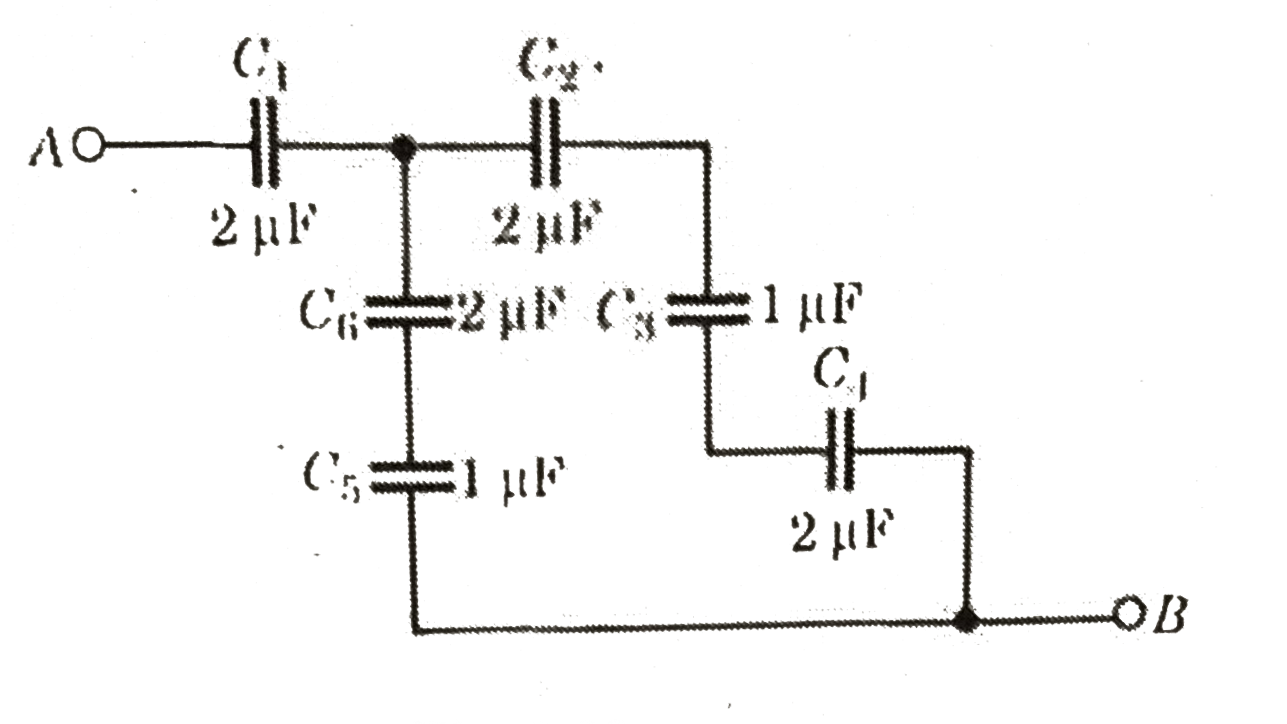
Calculate the equivalent capacitance between the points A and B of the circuit shown in figuer.03:00View Solution
Calculate the equivalent capacitance between points A and B of the combination shown in figure.01:02View Solution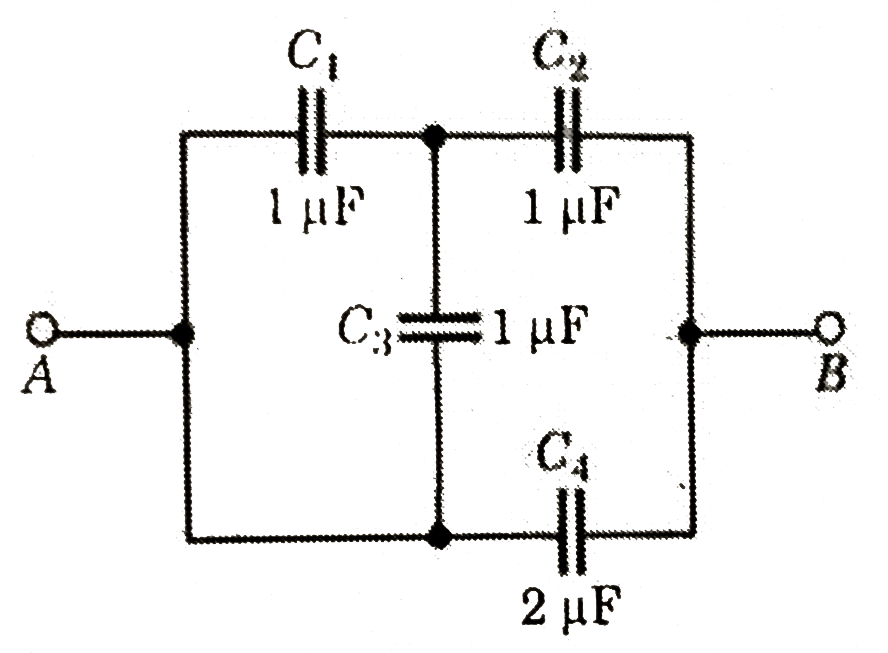
Find the equivalent capacitance between points A and B for the network shown in figure.01:43View Solution
find the capacitance between the points A and B of the assembly shown in figure.02:44View Solution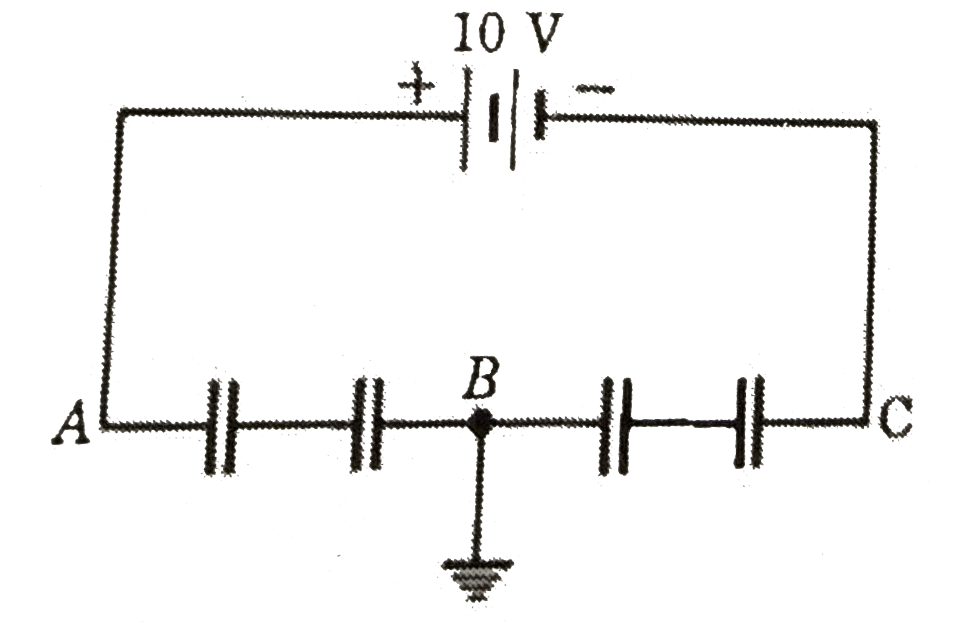
Four capacitors of equal cpacitances are connected in series with a battery of 10 V, as shown in figure. The middle point B is connected to the earth. What will be the potentials of the points A and C?03:32View Solution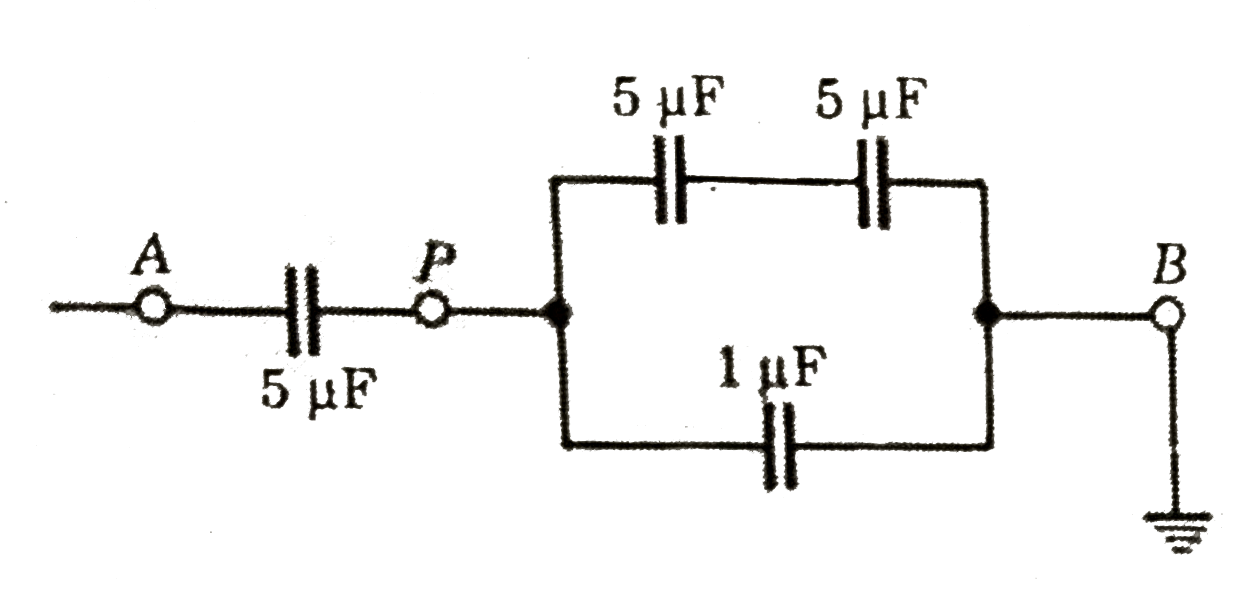
In the circuit shown in figure. If point B is earthed and A is kept at 1500 V, then calculate the potential at the point P.05:49View Solution
find the charges on the capacitors in figure. And the potential differences across them.05:12View SolutionA variable capacitor has n plates and the distance between two successive plates is d. determine its capacitance.
02:09View Solution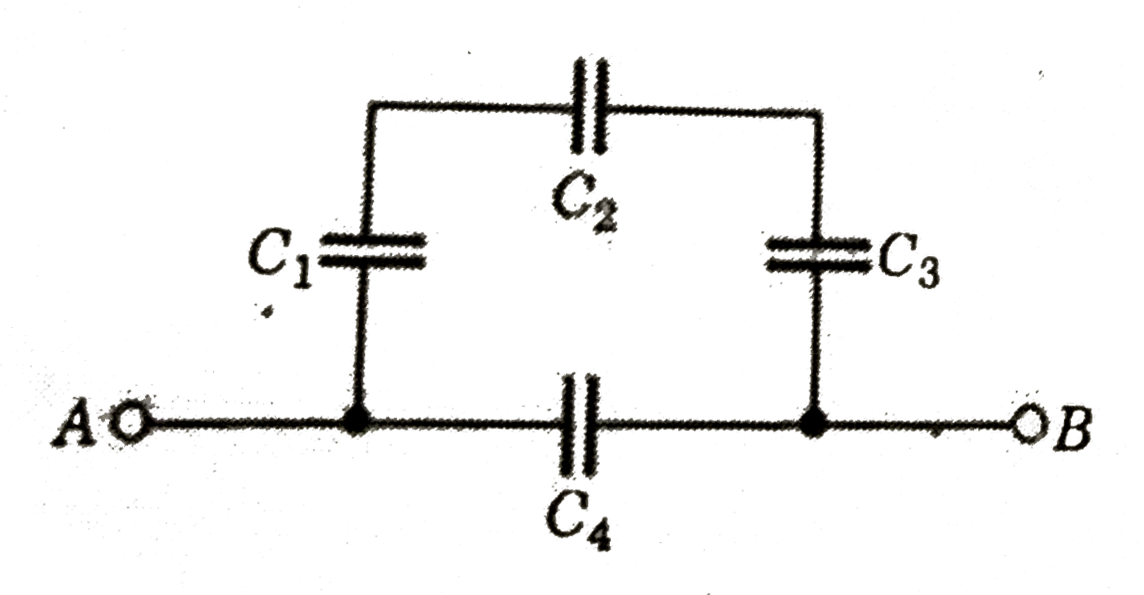
In the network shown in figure. `C_(1)=C_(2)=C_(3)=C_(4)=10muF`. Find th equivalent capacitance between the points A and B, what will be the charge on each capacitor?04:27View Solution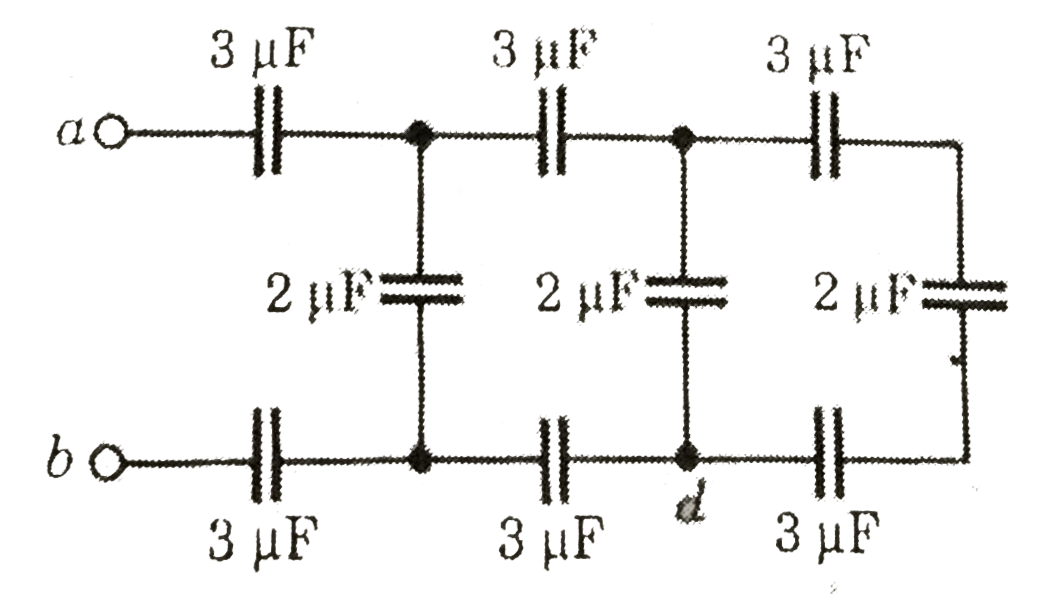
For the network shown in figure. Compute.
(i). The equivalent capacitance between points and b.
(ii). The charge on each of the capacitors nearest a and b when `V_(ab)=900V`.
(iii). `V_(cd),` when `V_(ab)=900V`.10:00View SolutionA 12 pF capacitor is connected to a 50 V battery. How much electrostatic energy is stored in the capacitor ?
02:22View SolutionAn electronic flash lamp has 10 capacitors, each 10 `muF`, connected in parallel. The lamp is operated at 100 volt. How much energy will be radiated in the flash?
02:21View SolutionFind the capacitance of a capacitor having a charge of `6xx10^(-7)C` and energy of `4.5xx10^(-4)J`
02:27View SolutionTwo capacitors of capacitances `4muF` and `6muF` are connected in series with a battery of 20 V. find the energy supplied by the battery.
02:50View SolutionTwo capacitors of capacitances `20 .0pF` and `50.0pF ` are connected in series with a `6.00V bettery . Find (a )the potential difference across each capacitor and (b) the energy stored in each capacitor .
04:18View SolutionA capacitor charged from a 50 V d.c. supply is found to have charge of `10 muC`.
What is the capacitance of the capacitor and how much energy is stored in it?01:43View SolutionThe plates of a parallel plate capacitor have an area of `100cm^(2)` each and area separated by 2.5 mm. the capacitor is charged to 200V. Calculate the energy stored in the capacitor.
04:24View Solution`A` 800 `pF` capacitor is charged by a `100 V` battery. After sometime, the battery is disconnected. The capacitor is then connected to another `800 pF` capacitor. What is the electrostatic energy stored ?
04:36View SolutionA `20muF` capacitor charged to 100 V is connected in parallel to a `10muF` capacitor charged to 100 V. find the loss in energy.
02:24View SolutionTwo insulated metallic spheres of `3mu F` and `5 muF` capacitances are charged to `300 V` and `500 V` respectively. The energy loss, when they are connected by a wire is
03:00View SolutionThree capacitors of 10,15 and 30 `muF` are connected in series and on this combination a potential difference of 60 V is applied. Calculate the charge, potential difference and energy stored on each capacitor.
02:10View SolutionTwo capacitors are connected in parallel and the energy stored is 18 J, when a potential difference of 6000 V is applied across the combination. With the same capacitors connected in series, the energy stored is 4 J from the same potential difference. what are the individual capacitances?
09:41View SolutionTwo capacitors of capacitances `25muF and 100 muF` are connected in series and are charged by a battery of 120 V. the battery is then removed. The capacitors are now separated and connected in paralle. Fiond (i) p.d. across each capacitor (ii) energy-loss in the process.
11:25View Solution
In the network shown in figure. `C_(1)=2.0muF,C_(2)=6.0 and C_(3)=2.5muF`. Determine (i) total capacitance, charge and energy of the system (ii) charges on separated capacitors (iii) potential differences across the separate capacitors.06:05View SolutionTwo parallel plates, separated by 2 mm of air, have a capacitance of `3xx10^(-14)muF` and are charged to a potential of 200 V. then without touching the plates, they are moved apart till the separation is 6 mm. (i) what is the potential differene between the plates ? (ii) what is the change in energy?
05:48View SolutionThe radii of cahrged metallic spheres are 5 cm and 10 cm. both have a charge of 75 `muC`. Both the spheres are connected together with a conducting wirre. Calculate (i) the quantity of charge transferred through the wire (ii) the common potential of the spheres after connecting them.
06:43View SolutionA parallel-plate capacitor having plate are `100 cm ^2` and separation 1.0 mm holds a charge of `0.12 muC` when connected to a 120 V battery. Find the dielectric constant of the material filling the gap.
02:37View SolutionTwo parallel plate capacitors, each of capacitance `40 muF, are connected is series. The space between the plates of one capacitor is filled with a dielectric material of dielectric constant K =4. Find the equivalent capacitance of the system.
02:06View SolutionA parallel-plate capacitor of consists of 26 metal strips, each of `3cmxx4cm`, separated by mica sheets of dielectric constant 6 and uniform thickness 0.2 mm. find the capacitance.
03:04View SolutionA parallel-plate capacitor of capacity `0.5pF` is to be constructed using paper sheets of thickness 0.04 mm as dielectric. Find how many circular metal foils of diameter 0.1m will have to be used. Take the dielectric constant of peper used as 4.
07:37View SolutionA slab of material of dielectric constant K has the same area as the plates of a parallel capacitor, but has a thickness `((3)/(4) d)`,
where d is the separation of the plates. How is the capacitance changed when the slab is inserted between the plates02:20View SolutionCalculate the capacitance of a spherical capacitor consisting of two concentric spheres of radil 0.50m, 0.60m. The material filled in the space between the two spheres has a dielectric constant of 6.
02:04View SolutionThe insulated plates of a parallel plate capacitor has a charge density `sigma`. Show that that the work done in changing the distance from `d_(1)` to `d_(2)` is
05:01View Solution
problem for self practive questions and complete solutions for chapter CAPACITORS of DHANPAT RAI & CO PHYSICS (HINGLISH) of Class 12
